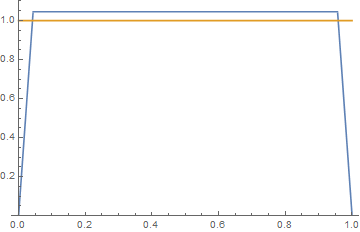$\newcommand{\ep}{\varepsilon}\newcommand{\de}{\delta}$Instead of $\int_0^1|f-1|>2\ep$, let us write
\begin{equation*}
\ep:=\frac12\int_0^1|f-1|.
\end{equation*}
We want to show that
\begin{equation*}
\min\Big(\int_0^{1/4}f,\int_{3/4}^1 f\Big)\le\frac14-\frac\ep8. \tag{!}
\end{equation*}
Without loss of generality (wlog), $\ep>0$.
By approximation, wlog the function $f\in C^2[0,1]$ with $f''>0$ on $(0,1)$ and the set $\{x\in[0,1]\colon f(x)\ge1\}$ is an interval $[a,b]$ such that $0<a<b<1$, with $f(a)=f(b)=1$.
So,
\begin{equation*}
\ep=\ep_1+\ep_2,
\end{equation*}
where
\begin{equation*}
\ep_1:=\int_0^a(1-f),\quad\ep_2:=\int_b^1(1-f).
\end{equation*}
Let
\begin{equation*}
\de_1:=\frac14-\int_0^{1/4}f=\int_0^{1/4}(1-f),\quad
\de_2:=\frac14-\int_{3/4}^1 f=\int_{3/4}^1(1-f).
\end{equation*}
It suffices to show that
\begin{equation*}
\max(\de_1,\de_2)\overset{\text{(?)}}\ge\frac{24}{121}\,\ep, \tag{*}
\end{equation*}
which will improve the constant factor in (!) from $1/8=0.125$ to $\frac{24}{121}=0.19834\dots$.
Moreover, the factor $\frac{24}{121}=0.19834\dots$ in the lower bound $\frac{24}{121}\,\ep$ in (*) is the best possible.
Our main tool here will be the following lemma.
Lemma 1: Suppose that $g\in C^2[0,1]$ with $g''<0$ on $(0,1)$ and $g(u)=0$ for some $u\in(0,1)$. Then the function $h\colon[0,1]\to\mathbb R$ defined by
\begin{equation*}
h(x):=\frac1{(x-u)^2}\,\int_u^x g
\end{equation*}
for $x\in[0,1]\setminus u$, with $h(u):=g'(u)/2$, is nonincreasing. Here, $\int_u^x:=-\int_x^u$ if $x<u$.
The proof of this lemma consists in a triple application of the special-case l'Hospital-type rule for monotonicity given by Proposition 4.1.
In particular, it follows from Lemma 1 (applied to $g:=f-1$) that
\begin{equation*}
b-a\ge1/2. \tag{0}
\end{equation*}
Indeed, suppose (0) is false. Then there are $l_1\in(0,a)$ and $l_2\in(0,1-b)$ such that $l_1+l_2=b-a$ (e.g., let $l_1:=\frac{b-a}{a+1-b}\,a$ and $l_1:=\frac{b-a}{a+1-b}\,(1-b)$). By Lemma 1 (it helps to draw a picture),
\begin{equation*}
\int_a^{a+l_1}(f-1)\le\frac{l_1^2}{a^2}\,\int_a^0(f-1)=\frac{l_1^2}{a^2}\,\int_0^a(1-f)
=\frac{l_1^2}{a^2}\,\ep_1\le\ep_1, \tag{0.5}
\end{equation*}
so that $\int_a^{a+l_1}(f-1)\le\ep_1$, and the latter inequality is strict if $\ep_1>0$. Similarly, $\int_{a+l_1}^b(f-1)=\int_{b-l_2}^b(f-1)\le\ep_2$, and the latter inequality is strict if $\ep_2>0$. So,
\begin{equation*}
\ep=\int_a^b(f-1)=\int_a^{a+l_1}(f-1)+\int_{a+l_1}^b(f-1)\le\ep_1+\ep_2=\ep,
\end{equation*}
and the latter inequality is strict, since $\ep>0$ and hence either $\ep_1>0$ and $\ep_2>0$. Thus, we have $\ep<\ep$, a contradiction, which proves (0).
In view of (0) and by symmetry, it is enough to consider the following two cases:
\begin{equation*}
0<a\le1/4,\quad 3/4\le b<1 \tag{i}
\end{equation*}
and
\begin{equation*}
1/4<a\le1/2,\quad 3/4\le b<1 \tag{ii}
\end{equation*}
Consider now case (i). Then, letting
\begin{equation*}
\eta_1:=\int_a^{1/4}(f-1),\quad\eta_2:=\int_{3/4}^b(f-1),
\end{equation*}
we have
\begin{equation*}
\de_1=\ep_1-\eta_1,\quad\de_2=\ep_2-\eta_2. \tag{1.5}
\end{equation*}
Let now
\begin{equation*}
c:=f(1/4)-1[\ge0],\quad d:=f(3/4)-1[\ge0],
\end{equation*}
\begin{equation*}
p(x):=c+(x-1/4)\frac{d-c}{1/2}=\frac{3c-d}2+2x(d-c).
\end{equation*}
Then $p(1/4)=c=f(1/4)-1$ and $p(3/4)=d=f(3/4)-1$. So, by the concavity of $f$, we have $p\le f-1$ on $[1/4,3/4]$ and $p\ge f-1$ on $[0,1]\setminus[1/4,3/4]$. So,
\begin{equation*}
\eta_1=\int_a^{1/4}(f-1)\le\int_a^{1/4}p=\frac{5c-d}{16};
\end{equation*}
similarly, $\eta_2\le\int_a^{1/4}p=\frac{5d-c}{16}$, whence
\begin{equation*}
\eta_1+\eta_2\le\frac{5c-d}{16}+\frac{5d-c}{16}=\frac{c+d}4,
\end{equation*}
whence, by (1.5),
\begin{equation*}
\de_1+\de_2=\ep_1+\ep_2-(\eta_1+\eta_2)=\ep-(\eta_1+\eta_2)\ge\ep-(c+d)/4;
\end{equation*}
and
\begin{equation*}
\int_{1/4}^{3/4}(f-1)\ge\int_{1/4}^{3/4}p=\frac{c+d}4,
\end{equation*}
so that
\begin{equation*}
\ep_1+\ep_2=\ep=\int_a^b(f-1)=\int_a^{1/4}(f-1)+\int_{1/4}^{3/4}(f-1)+\int_{3/4}^b(f-1)
\ge\eta_1+\frac{c+d}4+\eta_2,
\end{equation*}
whence, by (1.5), $\de_1+\de_2\ge(c+d)/4$.
So,
\begin{equation*}
\max(\de_1,\de_2)\ge\frac12\,(\de_1+\de_2)
\ge\frac12\,\max((c+d)/4,\ep-(c+d)/4)\ge\frac\ep4.
\end{equation*}
So, (*) holds if case (i) takes place.
Consider now case (ii). By Lemma 1 (cf. (0.5)),
\begin{equation*}
\ep=\int_a^b(f-1)\le\frac{(b-a)^2}{a^2}\,\int_0^a(1-f)\le\frac{(1-a)^2}{a^2}\,\int_0^a(1-f)
=\frac{(1-a)^2}{a^2}\,\ep_1,
\end{equation*}
\begin{equation*}
\ep-\eta_2=\int_a^{3/4}(f-1)
\ge\frac{(3/4-a)^2}{(b-a)^2}\,\int_a^b(1-f)=\frac{(3/4-a)^2}{(b-a)^2}\,\ep\ge\frac{(3/4-a)^2}{(1-a)^2}\,\ep,
\end{equation*}
and, similarly,
\begin{equation*}
\ep_1-\de_1=\int_a^{1/4}(f-1)\le\frac{(a-1/4)^2}{a^2}\int_a^0(f-1)
=\frac{(a-1/4)^2}{a^2}\,\ep_1,
\end{equation*}
which implies
\begin{equation*}
\de_1\ge n(a)\ep_1\ge m(a)\ep, \tag{4}
\end{equation*}
where
\begin{equation*}
n(a):=1-\frac{(a-1/4)^2}{a^2},\quad m(a):=\frac{a^2}{(1-a)^2}n(a).
\end{equation*}
So,
\begin{equation*}
\de_2=\ep_2-\eta_2=-\ep_1+(\ep-\eta_2)\ge-\de_1/n(a)+\frac{(3/4-a)^2}{(1-a)^2}\,\ep.
\tag{5}
\end{equation*}
Minimizing now $\max(\de_1,\de_2)$ over all $\de_1,\de_2,a$ such that $1/4\le a<1$, $\de_1\ge m(a)\ep$ (cf. (4)), and $\de_2\ge-\de_1/n(a)+\frac{(3/4-a)^2}{(1-a)^2}\,\ep$ (cf. (5)), we get
$\max(\de_1,\de_2)\ge\frac{24}{121}\,\ep$ in case (ii), so that (*) holds in case (ii) as well.
This calculation takes about 0.11 sec with Mathematica:

$\Box$
Remark 1: To show without Mathematica that $\max(\de_1,\de_2)\ge\frac{24}{121}\,\ep$ in case (ii), one can do as follows. Rewrite the conditions $\de_1\ge m(a)\ep$ and $\de_2\ge-\de_1/n(a)+\frac{(3/4-a)^2}{(1-a)^2}\,\ep$ as
\begin{equation}
\de_1/\ep\ge\max(A,(B-\de_2/\ep)K),
\end{equation}
where $A:=m(a)$, $B:=\frac{(3/4-a)^2}{(1-a)^2}$, and $K:=n(a)$. If $\de_2\ge\frac{24}{121}\,\ep$, we are done. Otherwise,
\begin{equation}
\de_1/\ep\ge
\max(m(a),M(a)),
\end{equation}
where
\begin{equation}
M(a):=(B-\tfrac{24}{121})K=\Big(\frac{(3/4-a)^2}{(1-a)^2}-\frac{24}{121}\Big)n(a).
\end{equation}
Note that $m$ is increasing on $[0,1]$, $M$ is decreasing on $[1/4,1/2]$, and $m(\frac 5{16})=\frac{24}{121}=M(\frac 5{16})$. It follows that for all $a\in[1/4,1/2]$
\begin{equation}
\de_1/\ep\ge\max(m(a),M(a))\ge\tfrac{24}{121},
\end{equation}
as was proved by Mathematica.
Remark 2: Following the lines of the consideration of case (ii) (with $a=5/16$, $\ep\downarrow0$, and $b\uparrow1$), one can see that the factor $\frac{24}{121}=0.19834\dots$ in the lower bound $\frac{24}{121}\,\ep$ in (*) is the best possible.
More explicitly, for $k\in(0,1)$ and $x\in[0,1]$, let
\begin{equation}
f(x):=\left\{
\begin{aligned}
k \left(x-5/16\right)+1 & \text{ if }x\le\frac{5 k+16}{11 k+16} \\
\frac{(25 k^2+352 k+256) (1-x)}{96 k} & \text{ if }x\ge\frac{5 k+16}{11 k+16}.
\end{aligned}
\right.
\end{equation}
Then $f$ satisfies all the conditions. Moreover, then
\begin{equation}
a=5/16,\quad b=\frac{25 k^2+256 k+256}{25 k^2+352 k+256},
\end{equation}
and
\begin{equation}
\frac{\de_1}\ep=\frac{\de_2}\ep=\frac{24 \left(25 k^2+352 k+256\right)}{(25 k+176)^2}\to\frac{24}{121}
\end{equation}
as $k\downarrow0$.
Here is the plot of this particular $f$ for $k=1/2$:




